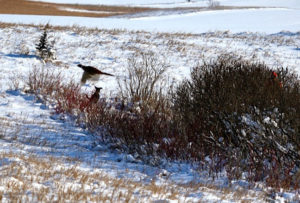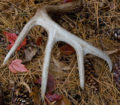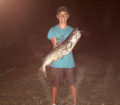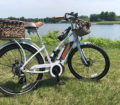
Strategically planted thickets and shelter belts, tall grass prairie and cattails surrounding restored wetlands are perfect habitat for wildlife and also a good way to utilize ground not really suited to growing crops.
By Steve Weisman
What a crazy winter we have had. Unfortunately, I don’t think it’s quite over. Like a pendulum, the temperatures have been up and down. We’ve had more rain and ice than I can remember in a long time. When we get those rains and ice systems coming through, then I worry about how the upland game birds, wild animals and our songbirds will do. Luckily, although we have had lots of wind, we have been fortunate to not have much snow-that is until the foot of snow that recently fell.
My wife tells me to lighten up a bit, since Mother Nature is going to do her thing, and there really isn’t much we can do about it! So, while she is correct when she says that all we can do about the weather is talk about it, there really are some things we can do for our wildlife. It’s about their habitat and what we can do to provide them habitat.
Whether we are on a farm, acreage or in town, there are things we can do to provide our wildlife with protection during the winter weather swings. This is a good time to think about this and begin making preparations for next year.
Of course, farm areas offer the most habitat opportunities.
I know right away people will argue that by doing this, we are taking away valuable land that will provide exceptional small grain crops yields. I agree that that this is important, but there are bits and pieces of land that just don’t have a very good crop history. Maybe the soil is lighter and needs a lot of fertilizer or it is very hilly and is subject to erosion during rains. Finally, maybe it is a lowland area that floods and often times needs to be replanted. These are the areas I am talking about, and by turning these troublesome areas into wildlife areas, we are actually getting optimal use out of the land and at the same time being good stewards of the land!
We are also helping the land utilize the water rather than just sending it on downstream for the next landowner to have to deal with. Yes, it does take planning, and during spring planting and fall harvesting the planter and combine will have to avoid those conservation areas, but oh my are there benefits.
The good news is there are people out there who are experts at helping to make sound conservation plans: management biologists, wildlife specialists, habitat specialists, the local Natural Resource Conservation Service (NRCS), Farm Service Agency (FSA) and the Soil and Water Conservation District (SWCD) and non-profit organizations like Pheasants Forever and Ducks Unlimited.
This private lands effort involves contacting and advising landowners about possible conservation practices that could be put into place on their lands. Wetlands are designed, winter food plots are developed and planted, native grass seedings, buffer strips, edge of field practices and tree plantings/shelterbelts are designed. Funding to get these designed practices on the ground comes from the USDA, Iowa DNR, and private organizations.
To me, the diversity of cropland combined with wise conservation practices means dollars and sense and an awesome way to protect the landscape, improve water quality and protect our wildlife. Now that’s a win-win proposition.
So, then we move on to acreages. Although a much smaller version, the acreage offers a lot of options for wildlife. Depending on the size of the acreage, acreage owners can plant a series of tree plantings to offer protection for wildlife and can act as a living snow fence. In between the rows of trees and shrubs, native grasses can be planted, which further protect wildlife. Then, by adding colorful forbes (flowers), songbirds, butterflies and other insects can be attracted. Once again, conservation practices can help slow surface water runoff and to help with overall water quality.
Finally, we take a look at lots in town. Too small? Nope! We can provide shrubs around our homes to offer songbirds both nesting protection and winter protection. We can plant perennial gardens (groupings) with a mix of flowers and shrubs.
By adding strategically located bird feeders and bird waterers, we will provide a safe haven for wildlife and give us some great viewing opportunities.
If you live in a wooded area, you might have some surprise visitors: wild turkeys, pheasants and deer. Funny how they know where the food is located!
So, really, no matter whether it is a farm, acreage or a city lot, there are conservation practices we can implement to enhance the land that we own.















